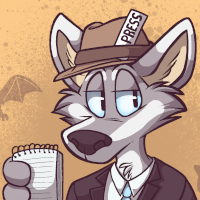The Art and Evolution of TwoKinds, Volume 1, by Thomas Fischbach – review by Fred Patten.
by Patch O'Furr
Submitted by Fred Patten, Furry’s favorite historian and reviewer.
 The Art and Evolution of TwoKinds, Volume 1, by Thomas Fischbach
The Art and Evolution of TwoKinds, Volume 1, by Thomas Fischbach
Apple Valley, CA, Keenspot Entertainment, December 2016, hardcover $29.99 (89 [+ 1] pages)
This is a large (8.5 x 10 inches) deluxe color artbook featuring Fischbach’s TwoKinds online comic strip cast. Every page is printed in full color on slick, glossy paper. It is a visual feast for fans of TwoKinds, and of all fans of mild cheesecake featuring anthropomorphic characters.
Despite the title, there is nothing here from the comic strip itself. You will not see how TwoKinds has evolved artistically over the dozen years that it has been running (since October 22, 2003). Instead this is a collection of Fischbach’s recent paintings of his main characters. Most of them have appeared on his DeviantArt gallery with the dates painted, and they are all from late 2014 to 2016. This is disappointing in terms of not really seeing how TwoKinds has evolved artistically over twelve years. But, frankly, Fischbach’s art was pretty crude when he began. Every painting in this artbook is in his current, much higher-quality style. It’s what most purchasers will prefer.


 La Saga d’Atlas & Axis, t.4, by Pau.
La Saga d’Atlas & Axis, t.4, by Pau. A Glimpse of Anthropomorphic Literature, AnthroAquatic, ed.
A Glimpse of Anthropomorphic Literature, AnthroAquatic, ed. Last Dance of the Phoenix, by James R. Lane
Last Dance of the Phoenix, by James R. Lane Peter & Company: A Comic Collection, by Jonathan Ponikvar.
Peter & Company: A Comic Collection, by Jonathan Ponikvar. Skeleton Crew, by Gre7g Luterman. Illustrated.
Skeleton Crew, by Gre7g Luterman. Illustrated. What does Furry have to do with politics? Nothing. Or a lot. (Kinda like kink). It’s up to you. Maybe you just like talking-animal media. Or maybe you like media that’s inseparable from a culture that’s cracking apart.
What does Furry have to do with politics? Nothing. Or a lot. (Kinda like kink). It’s up to you. Maybe you just like talking-animal media. Or maybe you like media that’s inseparable from a culture that’s cracking apart. Domino, by Kia Heavey.
Domino, by Kia Heavey. This is a side-story to Repino’s Mort(e),
This is a side-story to Repino’s Mort(e),